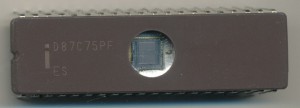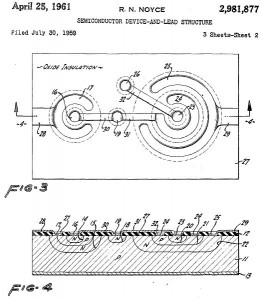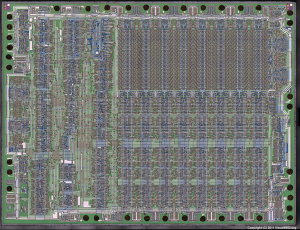April 29th, 2011 ~ by admin

Intel C8755A - 1977
When Intel released the 8755 in 1976 and 8755A in 1977 it provided an easy way to interface the 8080 and the 8085 to other components. It was a 16k (2kx8) EPROM with a pair of latched 8 bit I/O ports. This greatly reduced system chip counts and complexity of board design. The basic 8755A ran at 3Mhz (the later 8755A-2 ran at 5MHz) which allowed interfacing with the 8085AH with zero wait states. The 8755A continued to be used well into the 1980s with many processors (Intel and others)

Intel D87C75PF - 1988 Engineering Sample
By 1988 the 8755A was out of date, its 16k of EPROM space was insufficient for most designs and its power consumption was much higher then contemporary parts. Intel sought to remedy this with the release of the 87C75. The 87C75 is essnetially a 27C256 EPROM, and 82C55A port expander, and latches combined on a single chip. It was made on Intel CHMOSII-E process which reduced power consumption (from 1.5Watts to 500mW). It ran at a max of 5MHz and the EPROM was bumped up from 16k to 256k. It was designed to interface direction to the 8051, MCS-96 and i188 processors.
Why then do we find so few examples of the 87C75PF? The late 80’s and early 90’s also ushered in dozens of microcontrollers and embedded processors that had all of the 87C75’s features on chip; larger EPROM on die, more I/O ports, and the widespread use of Flash on microcontrollers effectively made the 87C75PF obsolete.
April 25th, 2011 ~ by admin
 On April 25th, 1961 Robert Noyce, then working at Farichild Semiconductor, received Patent 2,981,877 SEMICONDUCTOR DEVICE-AND-LEAD STRUCTURE. This was the patent for how to make integrated circuits, containing multiple silicon based transistors, on a single die. Six months prior Jack Kilby received a similar patent, but for geranium based devices. Silicon became, for a variety of reasons, the preferred material and 50 years later we now use some of the same principles to build IC’s with over a billion transistors on them. The diagram in the patent showed a device with 8 components on a single doe, 1 transistor, 2 diodes, 2 capacitors, and 3 resistors.
On April 25th, 1961 Robert Noyce, then working at Farichild Semiconductor, received Patent 2,981,877 SEMICONDUCTOR DEVICE-AND-LEAD STRUCTURE. This was the patent for how to make integrated circuits, containing multiple silicon based transistors, on a single die. Six months prior Jack Kilby received a similar patent, but for geranium based devices. Silicon became, for a variety of reasons, the preferred material and 50 years later we now use some of the same principles to build IC’s with over a billion transistors on them. The diagram in the patent showed a device with 8 components on a single doe, 1 transistor, 2 diodes, 2 capacitors, and 3 resistors.
In 1968 Noyce, and Gordon Moore (of Moore’s Law fame) left Fairchild and founded Intel. Fairchild Semiconductor was the ‘incubator’ of many such semiconductor companies, Intersil, Teledyne, Xicor and AMD were all founded by former Fairchild employees
April 21st, 2011 ~ by admin

RCA 1802E Die - 20x magnification - Visual6502.org
The talent at Visual6502.org continues. After imaging and building a complete simulator for the MOS 6502 they did the same for the Motorola 6800 (from which the 6502 was based).
We have sent Visual6502.org several chips and they have now imaged the RCA 1802 that we sent. What is very interesting is how little marking are on the die, the only that I could see was the number ‘10824.’ This particular chip was dated early 1981 though the 1802 COSMAC was designed in 1976 and was one of the first CMOS microprocessors. The 1802 had around 5000 transistors (Visual6502 will let us know exactly how many once they are done, and of course what each and every one of them does). For higher res shots and more info see here
April 7th, 2011 ~ by admin
Commodore USA has started taking pre-orders of its newly revamped Commodore 64 Home Entertainment system. Of course this version comes with Blu-Ray and a dual core Intel (gasp!) processor running a version of Ubuntu Linux, it will include a Commodore OS 1.0 emulator, which should run all your favorite C64 6502 based games.

Commodore USA C64 - 1.8 Dual core Atom - 2GB RAM
The Original C64 had 64k of RAM, the Intel Atom D525 has 112k of just L1 cache. At least the die size is similar :).
Commodore USA is also making modern version of the VIC computers for your enjoyment, albeit in slightly modified cases.
April 1st, 2011 ~ by admin
Technologizer has published a very interesting article on Osborne Computers, and its founder, Adam Osborne. Osborne computers was started 30 years ago (April 3rd 1981). They were the fastest growing, and fastest failing company in Silicon Valley, impressive even today. Adam Osborne was one of the most important people in Silicon Valley (along with Bill Gates and Steve Jobs). His books in the 70’s are still invaluable resources for collectors, I have several editions of ‘An Introduction to Microcomputers’ which provide an invaluable reference to some of the chip designs of the 1970’s and early 1980’s.
The Osborne 1, the first wildly successful portable, was based on a Zilog Z80A processor and ran the then popular CP/M OS. If it wasn’t for cash flow problems, Osborne computers may very well have still been making computers today. It is also interesting that Mr. Osborne had a habit of picking designs that ended up to be not very successful (he chose the Zilog Z8000 and Intel 8089 I/O processor as ‘Chips of the Year’ in 1980)






